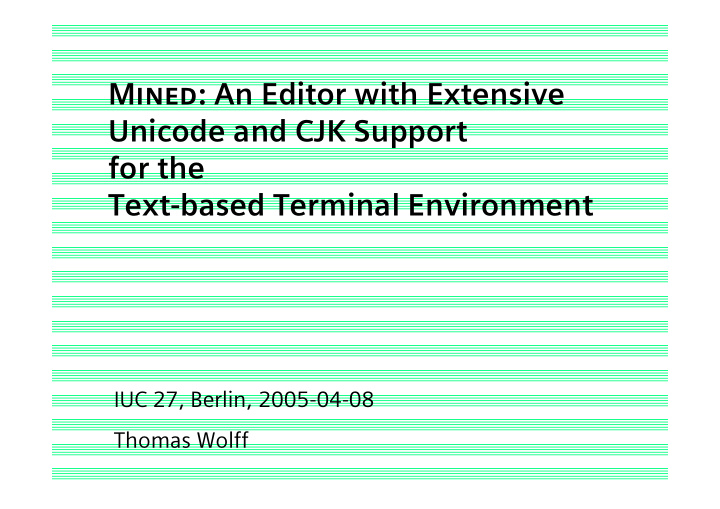



Mined : An Editor with Extensive Unicode and CJK Support for the Text-based Terminal Environment IUC 27, Berlin, 2005-04-08 Thomas Wol��
Mined : introduction � A text editor • suitable for editing text • suitable for editing programs � Editing environment • text-mode terminal (xterm, mlterm, hanterm, cxterm, rxvt, linux console) • non-graphical UI: more light- weight interaction, seemless integration into command-line workflows • Mined was the first editor that supported UTF-8 in this environ�ent Dr. Thomas Wolff 1 IUC 27 Mined
Mined : «IUC» support � Internationalisation support • encoding support: UTF-8, CJK, and others • character and script information • character input support, input methods � Encoding environment • text encoding: automatic detection, flexible handling » configurable detection » mixed-encoding editing, switching online • terminal encoding: automatic detection » 8 bit vs. UTF-8 vs. CJK » various sets of character width properties Dr. Thomas Wolff 2 IUC 27 Mined
Mined : overview � User interface • simple and intuitive • affirmative toward modern interaction paradigms » comprehensive menus » mouse control, wheel scrolling » scrollbar navigation � Program editing features • program structure, auto-indent • identifier search functions (multi-file) • HTML highlighting and tag matching • multiple lines in search/replacement patterns • multi-file copy/paste • visual indications, binary transparency Dr. Thomas Wolff 3 IUC 27 Mined
Typographic editing support � Smart quotes • smart quotes mode with different styles • straight quotes (as from keyboard) are replaced with typographic quote marks for insertion • opening/closing quote mark » depending on context » nested handling for double/single quotes » special heuristics for CJK quotes (without space context) � Smart dashes • “ --” � “–” • “--” � “—” • <Hebrew context>”-” � ־ (Maqaf) Dr. Thomas Wolff 4 IUC 27 Mined
Input support: character input � Mnemonic input • RFC 1345 with completions • HTML mnemonics, TeX mnemonics • useful supplements � Numeric input • hex, octal, decimal • native encoding, Unicode value • ISO 14755 � Accented input • accent prefix function keys • extensions for Vietnamese multiple accent combinations Dr. Thomas Wolff 5 IUC 27 Mined
Input support: input methods � Simple keyboard mapping • Greek, Cyrillic, Hebrew, Arabic, Thai � Input methods • CJK • extended keyboard mapping » multi-character input sequences » ambiguous mappings » resolution with selection menu (“pick-list”) • Radical/Stroke two-level selection menus � “Out-of-the-box” approach • all mapping tables built-in » all input methods are always available, even on legacy systems Dr. Thomas Wolff 6 IUC 27 Mined
Character handling: combining characters � Combined display mode • “normal” handling of combining characters � Combined editing • move cursor “into” a combined character, edit parts � Separated display mode • provides clear view of combining characters in text Dr. Thomas Wolff 7 IUC 27 Mined
Character handling: script highlighting � Distinguish characters with similar-looking glyphs • coloured display of certain scripts Dr. Thomas Wolff 8 IUC 27 Mined
Character handling: Han character information � Information from Unihan database • pronunciation entries (configurable selection) » Mandarin, Cantonese, (Sino-)Japanese, Korean, Vietnamese • semantic description of character (in English) » automatic typographic fixed to descriptions Dr. Thomas Wolff � IUC 27 Mined
Character handling: interactive conversion � Case toggle • handles Greek final sigma, Turkish i � Hiragana/Katakana toggle • using case toggle function key � Latin-1 / UTF-8 toggle • search for non-matching character codes • conversion function � Mnemonic conversion • cursor on “oe” » ESC ä � “ö” » ESC ç � “œ” » ESC å � “ø” Dr. Thomas Wolff 10 IUC 27 Mined
Terminal feature detection: locale trouble � Why the locale mechanism fails » export LC_CTYPE=my_country.UTF-8 » installed lo�ale: vendor_country.utf8 • user has trouble to find a suitable locale on each machine » if proper encoding is found, language/country may not match • want to install fr_FR.UTF-8? � system admin doesn�t care! • only some tools / terminals use system locale data » esp. xterm maintains its own width data • heterogeneous network: rlogin / telnet » terminal and application run on different machines » they see different system locale data » � it is in principle not possible to make sure that the locale data you get from the system matches the behaviour of your terminal Dr. Thomas Wolff 11 IUC 27 Mined
Terminal property auto-detection � Auto-detection mechanism • send test strings to terminal, request cursor position report » determine width of test strings, conclude width �ro�erties å لا ษษ 刈墢 String Width Conclusion UTF-8 terminal, no double-width support, with Arabic 6 LAM/ALEF ligature joining 7 UTF-8, no double-width, no LAM/ALEF ligature joining 8 UTF-8, double-width, with LAM/ALEF ligature joining (probably mlterm) 9 UTF-8, double-width, no LAM/ALEF ligature joining 10, 11, 14, 16, 17 CJK encoded terminal 15, 18 8 bit terminal or CJK terminal a U+0321 1 terminal supports combining characters 《》 U+301A U+301B 2 terminal does not support combining characters ‘’“”… ― - < 8 xterm version 157–166, corresponding Unicode U+FF60 version 3.2 > 8 xterm with option -cjk_width 0x8130A132 (« dž» in > 2 not a GB18030 terminal GB18030) 0xA1A4A1B1EAA5A6A1 < 10 non-native CJK terminal, Unicode width data (luit) Dr. Thomas Wolff 12 IUC 27 Mined
Mined : conclusion � Character encoding supported “out-of-the-box” • including input methods » users may quickly edit international text without config. trouble � Terminal interoperability » xterm, mlterm, hanterm, cxterm, rxvt, linux console � Good range of text and program editing features � Intuitive user interface � Robust text and file handling engine � Portability » Unix (Linux, Sun, HP, BSD, Mac, …), Windows (cygwin), D�S � Small-footprint behaviour Dr. Thomas Wolff 13 IUC 27 Mined
Recommend
More recommend